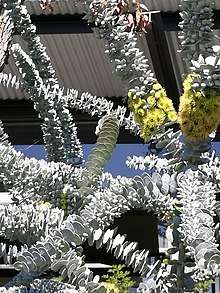Eucalyptus kruseana
Eucalyptus krueseana, commonly known as book-leaf mallee or Kruses's bookleaf mallee,[2] is a mallee that is endemic to inland Western Australia.[3]
| Book-leaf mallee | |
|---|---|
.jpg) | |
| Eucalyptus krueseana leaves and flowers. | |
 | |
| Scientific classification | |
| Kingdom: | Plantae |
| Clade: | Tracheophytes |
| Clade: | Angiosperms |
| Clade: | Eudicots |
| Clade: | Rosids |
| Order: | Myrtales |
| Family: | Myrtaceae |
| Genus: | Eucalyptus |
| Species: | E. kruseana |
| Binomial name | |
| Eucalyptus kruseana | |
| Synonyms[1] | |
|
Eucalyptus morrisonii Maiden | |
Description
The mallee has a straggly habit with multiple branches and typically grows to a height of 2.5 to 4 metres (8 to 13 ft)[3] and a width of 2 to 3.5 metres (7 to 11 ft).[4] In its native area it blooms in the winter and early spring, between June and September, producing inflorescences with yellow flowers.[3] The leaves have a rounded shape, are silver-blue leaves in colour and are crowded along branches.[2] It form buds in clusters from which the flowers form.[5]
The bark is smooth, grey to pinkish grey. Adult leaves remain in the juvenile phase and are ovate, sessile, about 2.2 centimetres (0.9 in) in length and width, concolorous, dull grey. Yellow flowers appear in winter to mid spring.[6] The leaves are aromatic when crushed and arranged opposite to each other.[7]
Like most mallees the small tree forms multiple stems from a lignotuber, but in cultivation E . kruseana often forms a single stem. The bark of the main stem is minni-ritchi style that is a reddish brown colour that forms longitudinal fissures and rolls back from the edges so the pale green to grey inner bark.[5] There are oil glands present in the branchlet pith.[7]
Taxonomy and naming
Eucalyptus kruseana was first formally described by the botanist Ferdinand von Mueller in 1895 in the Australasian Journal of Pharmacy.[8]
In 1910, Joseph Maiden described Eucalyptus morrisonii in the Journal of the Natural History and Science Society of Western Australia,[9] but in 1920 accepted that it was the same as E. kruseana and that E. morrisonii is therefore a synonym.[10]
The specific epithet honours John Kruse, a German born pharmacist, who worked in Melbourne.[11]
Distribution and habitat
It has a restricted distribution on granite hills and among granite outcrops east and south east of Kalgoorlie, from Cardunia Rock north of Karonie to Binyarinyinna Rock and east of Higginsville, usually found on or near granite rock in south eastern Western Australia where it grows in sandy-loam soils.
Use in horticulture
Book-leaf mallee is sold commercially as tube stock or in seed form. It is drought and frost tolerant and prefers a full sun position. Sold as an ornamental for small or large gardens,[4] it is used for privacy screening, for shade, for hedging or as a feature. Florists use the foliage and flowers in arrangements.[2] It can withstand hard pruning to give the plant a better shape.[5]
See also
References
- "Eucalyptus kruseana". Australian Plant Census. Retrieved 9 August 2019.
- "Eucalyptus kruseana - Kruses's Bookleaf Mallee". Australian Outback Plants. Retrieved 9 December 2017.
- "Eucalyptus krueseana". FloraBase. Western Australian Government Department of Parks and Wildlife.
- "Eucalyptus kruseana". Australian Native Plants. Retrieved 9 December 2017.
- "Bookleaf Mallee Eucalyptus kruseana" (PDF). Native Plants Notice. Kings Park and Botanic Gardens. Retrieved 9 December 2017.
- Brooker, M.I.H. & Kleinig, D.A. Field Guide to Eucalyptus, Bloomings, Melbourne 2001
- "Eucalyptus kruseana". Centre for Australian National Biodiversity Reseach. Retrieved 1 June 2020.
- "Eucalyptus kruseana". APNI. Retrieved 9 August 2019.
- "Eucalyptus morrisonii". APNI. Retrieved 9 August 2019.
- Maiden, Joseph (1920). A Critical Revision of the Genus Eucalyptus. Sydney: New South Wales Government Printer. pp. 51–55. Retrieved 9 August 2019.
- "Eucalyptus kruseana". Australian Native Plants Society. June 2016. Retrieved 9 December 2012.
